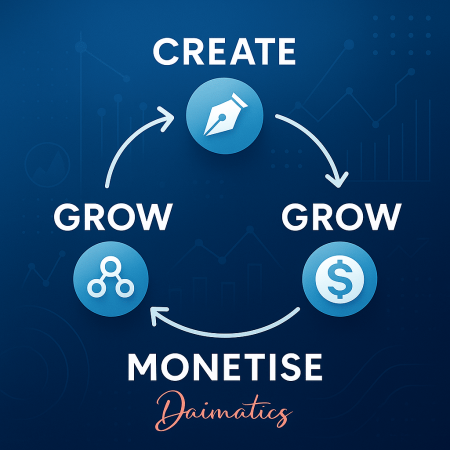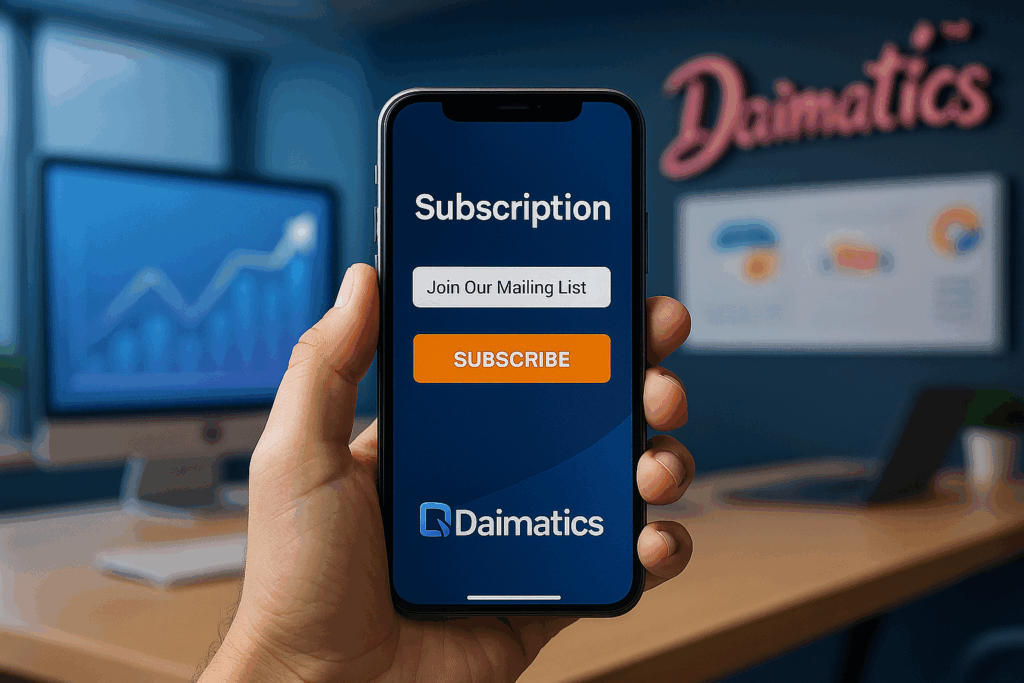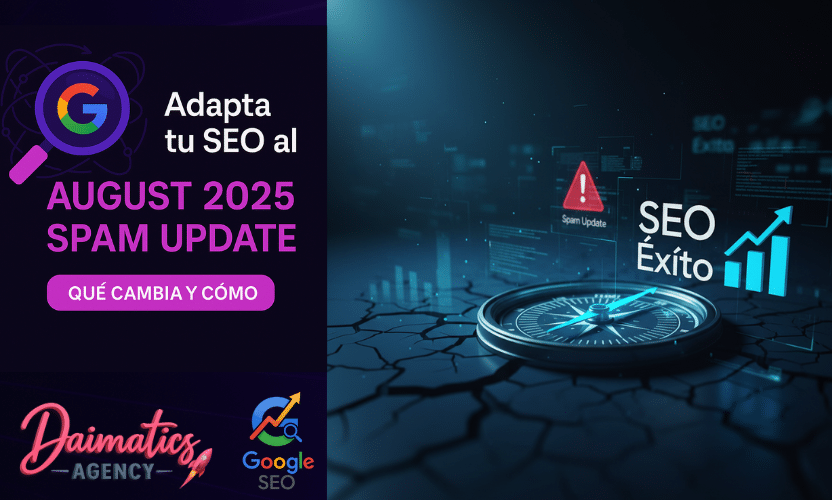Table of Contents
ToggleGenerating content within a digital marketing strategy that generates conversions and sales in the long term shouldn't be complicated, but when the goal is to obtain short-term results with specific content, things get complicated.
In this article you will discover what exactly is the content marketing, how to design an effective strategy to implement today, and how to avoid the most common mistakes. In addition, you will learn how to choose the best formats and frequencies according to your business objectives.
The importance of content marketing: is it really necessary?
Fact #1: Conversions are generated in multiple steps
Trying to achieve direct sales online is a difficult and competitive strategy. The solution is to cultivate a relationship with the user through valuable content, and then proceed to the sale.
The fundamental strategic cycle of content marketing is:
CREATE (community) → GROW (community) → MONETIZE (community)
You're probably already familiar with this process if you've ever sold anything: first you get to know the potential client, then you provide them with value and finally they end up buying from you.
Fact number 2: the relationship with social networks
Content marketing is closely linked to social media. Selling directly through social media doesn't usually work; you need to first capture the contact (email), cultivate the relationship, and then sell.
If there is no content strategy for social media, there is no real social media strategy.

How to sell with content marketing
There are three main ways to generate sales through content:
-
Direct sales from content: directly capture users from the web or social networks who register for webinars or downloads, where the sale is subsequently generated.
-
Email capture: capture emails with valuable materials (ebooks, guides, tutorials) and then follow up via email marketing.
-
Use of pixels and retargeting: incorporate pixels (Facebook Ads or Google Ads) to re-impact interested visitors who have not yet converted.
How to create content that really sells?
Content that really sells never tries to sell products or services directly, but rather:
-
Sell ideas and concepts.
-
It enhances the brand.
-
Amplify the need for what you offer.
To achieve this:
-
Don't write for yourself or your ego. Write with your end customer in mind.
-
Talk about your specific needs, problems, aspirations and concerns.
-
Always align your content with the specific stage your customer is in.
Practical example:
If you offer services seo For small businesses, don't talk about complex link-building strategies, but about specific benefits for this audience.
How to design content strategies that generate sales
To do it well you must answer clearly:
-
Who do you want to talk to? Find the space that the competition is not covering well or clearly improve its proposal.
-
Where is your potential customer at? Create content that generates a direct impact, adapted to their stage.
Create an avatar of your ideal customer
The avatar is a specific description of your target audience:
"David, 35, owns a digital services company. He spends his time programming and managing the company. He has a website with a seo worked, but needs to improve branding and attract customers automatically through content marketing.»
This avatar allows you to precisely define the content you generate.
Decide on the right format based on your strengths
List your team's capabilities to choose the best formats:
-
Reports or guides
-
Webinars and online seminars
-
Videos and tutorials (Youtube)
-
Blog articles with optimization seo
Establish the process clearly
Choose your process according to your objectives:
-
Direct sales from the content.
-
Email capture for email marketing.
-
Pixels and retargeting with Facebook Ads or Google Ads.
4 common mistakes in content marketing
Avoid these mistakes that limit the potential of your content:
-
Low quality content: Even if it's free, users dedicate time and attention to it, don't disappoint them.
-
Lack of clear goal: Creating content without specific goals is a waste of resources.
-
Content not very focused on the final sale: The content must guide the audience towards conversion.
-
Don't promote it: Without visibility, content is useless; invest in dissemination.
3 key tips to boost your content
-
Recycle and multiply: convert a report into several articles, or a webinar into several tutorials.
-
Amplify the most valuable content: Use paid advertising on featured content to maximize its impact.
-
use email marketing: create an active database and build your audience loyalty.

Must-have content types
Work with these formats to cover all your needs:
-
Leading content (evergreen): permanent content that generates authority and continuous traffic.
-
Promote them on social networks and optimize them for seo.
-
-
Content optimized for seo: Create a blog with regular content targeted at strategic keywords.
-
Success stories: Highly valued by users, they are perfect for pre-selling services and products.
-
Epic Seasonal Content: content that needs to be updated periodically to cover new developments.
-
Tutorials on Youtube: they provide added value and position quickly.
How to decide the publication frequency?
Ask yourself: What decision time does my potential client have?
-
For sales of complex products (ERP, expensive software): create leading, highly elaborate content, with monthly or bimonthly publication.
-
For quick sales (economical ecommerce): publish daily or several times a week.
Final conclusions
Creating an effective content marketing strategy requires thought, clear goals, and knowledge of best practices. Applying the advice in this article will put you on the right track.
a good one copywriter It will increase the conversion of your texts, especially if you have a clear initial strategy. This way, you will maximize your investment and results.
The biggest problem with content marketing today is the lack of strategy. Writing without a defined goal forces you to produce a lot of content without results. On the Internet there are thousands of bloggers and YouTubers publishing every day without success in conversions for this reason.
In short: the success of content marketing does not depend on quantity but on quality, a defined strategy and clear alignment with the commercial objectives of your business.
FAQ'S
Content marketing is a strategy that is based on creating, publishing and sharing useful and valuable content with the aim of attracting, capturing and retaining a specific audience. It is important because it generates trust and a relationship with potential customers before making a sale, increases organic visibility in search engines (seo), and establishes the brand as a benchmark within its sector.
To create an effective strategy you must follow several key steps:
Clearly define your goals: capture leads, improve the seo, generate conversions or increase loyalty.
Get to know your target audience in depth by creating avatars or buyer personas, to correctly focus the content you produce.
Choose the content format that suits your capabilities and your audience's preferences: videos, blogs, podcasts, downloadable guides, webinars, etc.
Establish an editorial calendar that ensures regularity and consistency with your audience.
Monitor results to continuously optimize your actions.
The types of content that work best to generate conversions are those that solve specific problems or needs of your target audience. Some of the most effective are:
Detailed guides and downloadable ebooks (Lead Magnets).
Webinars and practical tutorials that show how your product or service works.
Real case studies that build trust.
In-depth articles that rank well organically (content seo strategic).
Explanatory and testimonial videos.
The most common mistakes to avoid in your content marketing strategy are:
Creating content without a clear goal or strategic direction.
Producing low-quality, irrelevant or poorly focused content for the target audience.
Not adequately promoting the content created, thus reducing its visibility and impact.
Do not use techniques seo Basics that allow the content to be positioned well.
Ignoring the importance of monitoring and analyzing results to adjust the strategy.
To measure the success of your content marketing you need to track key metrics such as:
Organic traffic generated to your website or blog.
Conversion rate (leads generated or sales made from the content).
Increase subscriptions to your newsletter or social channels.
Organic positioning of content in search engines (seo).
Engagement: interactions on social networks, comments and time spent on your website.
With this data you can continuously optimize and adjust your strategies.







